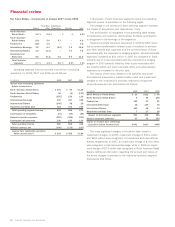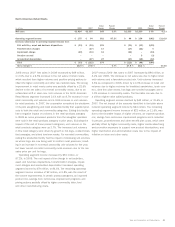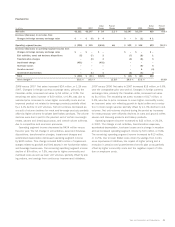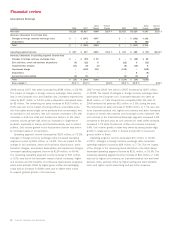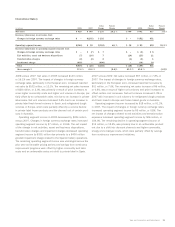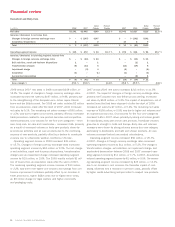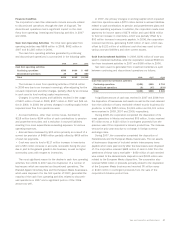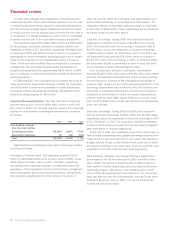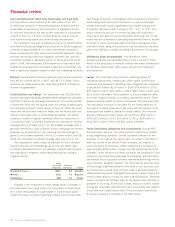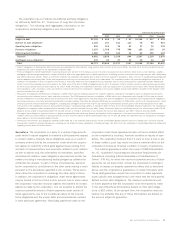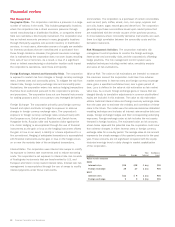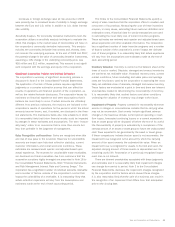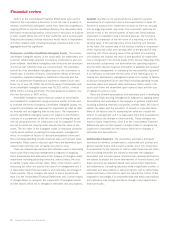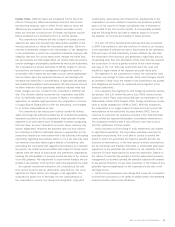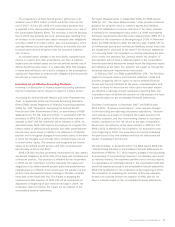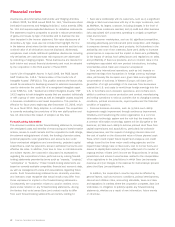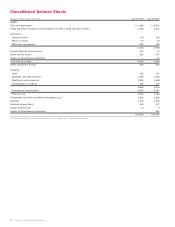Sara Lee 2008 Annual Report Download - page 32
Download and view the complete annual report
Please find page 32 of the 2008 Sara Lee annual report below. You can navigate through the pages in the report by either clicking on the pages listed below, or by using the keyword search tool below to find specific information within the annual report.
Financial review
Cash and Equivalents, Short-Term Investments and Cash Flow
The corporation’s cash balance of $1,284 million at the end
of 2008 was invested in interest-bearing bank deposits that are
redeemable on demand by the corporation. A significant portion
of cash and equivalents are held by the corporation’s subsidiaries
outside of the U.S. A portion of these balances will be used to
fund future working capital and other funding requirements.
The corporation has also recognized amounts for transformation
and other restructuring charges and at the end of 2008 recognized
a liability of approximately $110 million that relates primarily to
future severance and other lease and contractual payments. These
amounts will be paid when the obligation becomes due, and the
corporation expects a significant portion of these amounts will be
paid in 2009. The anticipated 2009 payments of cash taxes and
severance associated with previously recognized exit activities will
have a significant negative impact on cash from operating activities.
Dividend Annual dividend amounts paid per share by the corporation
were $0.41 in 2008, $0.50 in 2007, and $0.79 in 2006. Future
dividends are determined by the corporation’s Board of Directors
and are not guaranteed.
Credit Facilities and Ratings The corporation has a $1.85 billion
five-year revolving credit facility available which management considers
sufficient to satisfy its operating requirements. This facility expires
in December 2011 and the pricing under this facility is based upon
the corporation’s current credit rating. At June 28, 2008, the corpo-
ration had not borrowed under the facility and the facility does not
mature or terminate upon a credit rating downgrade. The facility
contains a number of typical covenants, which the corporation is
in compliance with, including a requirement to maintain an interest
coverage ratio of at least 2.0 to 1.0. The interest coverage ratio is
generally defined as a ratio of pretax income (excluding net interest
expense, any extraordinary or non-recurring non-cash charges or
gains), to net interest expense. For the 12 months ended June 28,
2008, the corporation’s interest coverage ratio was 11.2 to 1.0.
The corporation’s credit ratings by Standard & Poor’s, Moody’s
Investors Service and FitchRatings, as of June 28, 2008, were
as follows. Standard & Poor’s and Moody’s Investors Service have
the corporation’s long-term credit rating classified as having a
negative outlook.
Senior
Unsecured Short-term
Obligations Borrowings Outlook
Standard & Poor’s BBB+ A-2 Negative
Moody’s Baa1 P-2 Negative
FitchRatings BBB F-2 Stable
Changes in the corporation’s credit ratings result in changes in
the corporation’s borrowing costs. The corporation’s current short-
term credit rating allows it to participate in a commercial paper
market that has a number of potential investors and a historically
high degree of liquidity. A downgrade of the corporation’s short-term
credit rating would place the corporation in a commercial paper
market that would contain significantly less market liquidity than
it currently operates in with a rating of “A-2,” “P-2,” or “F-2.” This
would reduce the amount of commercial paper the corporation
could issue and raise its commercial paper borrowing cost. To the
extent that the corporation’s operating requirements were to exceed
its ability to issue commercial paper following a downgrade of its
short-term credit rating, the corporation has the ability to use avail-
able credit facilities to satisfy operating requirements, if necessary.
Off-Balance Sheet Arrangements The off-balance sheet
arrangements that are reasonably likely to have a current or future
effect on the corporation’s financial condition are lease transactions
for facilities, warehouses, office space, vehicles and machinery
and equipment.
Leases The corporation has numerous operating leases for
manufacturing facilities, warehouses, office space, vehicles and
machinery and equipment. Operating lease obligations are scheduled
to be paid as follows: $116 million in 2009, $76 million in 2010,
$53 million in 2011, $33 million in 2012, $26 million in 2013 and
$102 million thereafter. The corporation is also contingently liable
for certain long-term leases on property operated by others. These
leased properties relate to certain businesses that have been sold.
The corporation continues to be liable for the remaining terms of
the leases on these properties in the event that the owners of the
businesses are unable to satisfy the lease liability. The minimum
annual rentals under these leases are as follows: $29 million in
2009, $27 million in 2010, $23 million in 2011, $18 million in
2012, $14 million in 2013 and $61 million thereafter.
Future Contractual Obligations and Commitments During 2007,
the corporation exited a U.S. meat production plant that included
a hog slaughtering operation. Certain purchase contracts for the
purchase of live hogs at this facility were not exited or transferred
after the closure of the facility. These contracts, the majority of
which will expire by December 2009, represent the purchase of
approximately $158 million of hogs over the remaining life of the
contracts. Under the terms of these contracts, the corporation must
continue to purchase these live hogs and therefore, the corporation
has entered into a hog sales contract under which these hogs will be
sold to another slaughter operator. The corporation’s purchase price
of these hogs is generally based on the price of corn products, and
the corporation’s selling price for these hogs is generally based on
USDA posted hog prices. Divergent movements in these indices will
result in either gains or losses on these hog transactions. Expected
losses from the sale of these hogs are recognized when the loss is
probable of occurring. At the end of 2008, based on current market
pricing, the corporation deemed that it was not probable that material
future near-term losses would occur. The contractual commitment
for these purchases is included in the table below.
30 Sara Lee Corporation and Subsidiaries


